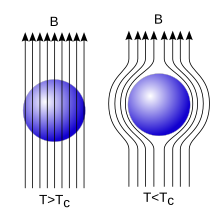| Articles about |
| Electromagnetism |
|---|
 |

In condensed-matter physics, the Meissner effect (or Meißner–Ochsenfeld effect) is the expulsion of a magnetic field from a superconductor during its transition to the superconducting state when it is cooled below the critical temperature. This expulsion will repel a nearby magnet.
The German physicists Walther Meißner (anglicized Meissner) and Robert Ochsenfeld[1] discovered this phenomenon in 1933 by measuring the magnetic field distribution outside superconducting tin and lead samples.[2] The samples, in the presence of an applied magnetic field, were cooled below their superconducting transition temperature, whereupon the samples cancelled nearly all interior magnetic fields. They detected this effect only indirectly because the magnetic flux is conserved by a superconductor: when the interior field decreases, the exterior field increases. The experiment demonstrated for the first time that superconductors were more than just perfect conductors and provided a uniquely defining property of the superconductor state. The ability for the expulsion effect is determined by the nature of equilibrium formed by the neutralization within the unit cell of a superconductor.
A superconductor with little or no magnetic field within it is said to be in the Meissner state. The Meissner state breaks down when the applied magnetic field is too strong. Superconductors can be divided into two classes according to how this breakdown occurs.
- In type-I superconductors, superconductivity is abruptly destroyed when the strength of the applied field rises above a critical value Hc. Depending on the geometry of the sample, one may obtain an intermediate state[3] consisting of a baroque pattern[4] of regions of normal material carrying a magnetic field mixed with regions of superconducting material containing no field.
- In type-II superconductors, raising the applied field past a critical value Hc1 leads to a mixed state (also known as the vortex state) in which an increasing amount of magnetic flux penetrates the material, but there remains no resistance to the electric current as long as the current is not too large. Some type-II superconductors exhibit a small but finite resistance in the mixed state due to motion of the flux vortices induced by the Lorentz forces from the current. As the cores of the vortices are normal electrons, their motion will have dissipation. At a second critical field strength Hc2, superconductivity is destroyed. The mixed state is caused by vortices in the electronic superfluid, sometimes called fluxons because the flux carried by these vortices is quantized.
Most pure elemental superconductors, except niobium and carbon nanotubes, are type I, while almost all impure and compound superconductors are type II.
- ^ "Meissner effect | physics". Encyclopedia Britannica. Retrieved 22 April 2017.
- ^ Meissner, W.; Ochsenfeld, R. (1933). "Ein neuer Effekt bei Eintritt der Supraleitfähigkeit". Naturwissenschaften. 21 (44): 787–788. Bibcode:1933NW.....21..787M. doi:10.1007/BF01504252. S2CID 37842752.
- ^ Landau, L. D.; Lifschitz, E. M. (1984). Electrodynamics of Continuous Media. Course of Theoretical Physics. Vol. 8 (2nd ed.). Butterworth-Heinemann. ISBN 0-7506-2634-8.
- ^ Callaway, D. J. E. (1990). "On the remarkable structure of the superconducting intermediate state". Nuclear Physics B. 344 (3): 627–645. Bibcode:1990NuPhB.344..627C. doi:10.1016/0550-3213(90)90672-Z.